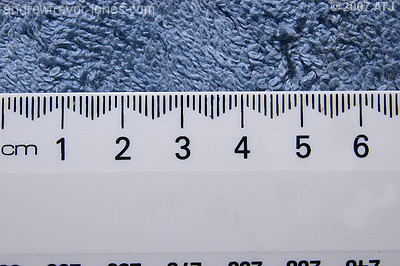
Closest focus for 18-55mm at 55mm
Original: Friday 6 June 2008 Update: Thursday 18 June 2009
I have three lenses that I currently use for underwater work, Nikon AF-S DX Zoom-Nikkor 18-55mm f/3.5-5.6G ED II, Nikon AF Micro-Nikkor 60mm f/2.8D and Tokina AT-X PRO DX 12-24mm f/4. Each lens has its strengths and weaknesses and each is more appropriate for certain subjects. Unlike above water photography, you can't change lenses while you are underwater, so you must choose the lens before the dive and live with it for the whole dive. Additionally, unlike above water photography, you need to minimise the amount of water between the lens and the subject so lens choice is somewhat more important. Below are my opinions of my three lenses and the sorts of dives/subjects I shoot with them.
Please note that the information presented below are my opinions based on my experiences with my gear in Ikelite housings. Other lenses may be more appropriate or have different characteristics in different housings.
The Nikkor 18-55mm f/3.5-5.6G gives me the most flexibility for subjects and is the lens I use most often if I'm unsure of the possible subjects on a dive. I use the Micro-Nikkor 60mm f/2.8D for macro work and the Tokina 12-24mm f/4 for large subjects.
The Nikkor 18-55mm f/3.5-5.6G lens is a very inexpensive lens that was sold as the kit lens for the Nikon D40, D40X and D60 cameras but can also be purchased separately. It is not an exceptional piece of optical hardware but does an admiral job. It is also the only Nikkor lens in that zoom range that can be used with the Ikelite port system as the much better Nikkor 17-55 f/2.8 is too large to fit.
Here are the specifications for the lens from Nikon Australia.
| Lens Construction (Groups/Elements) | 7/5 |
| Picture Angle with 35mm (135) format | 82°30'-27° |
| Picture Angle with Nikon DX format | 76°-28°50' |
| Minimum f/stop | 22-38 |
| Closest Marked Focus Dist [Macro Setting] | 0.28m/0.9 ft (through entire zoom range) |
| Maximum Reproduction Ratio | ~1:3 (derived experimentally) |
| Filter Attachment Size | 52mm |
| Diameter x Length (extension from lens mount) | 70.5 x 74.0mm |
| Weight (approx.) | 205g |
The photographs below give some idea how much magnification you can get from the lens when shooting at its closest focusing distance. Each is uncropped and only resized from the camera (either my D70 or D300).
At 55mm, this lens is capable of a reproduction ratio of around 1:2.8. While this doesn't mean a whole lot in digital photography, it at least gives a number for comparison. With a reproduction ratio of 1:1, a subject that is around 24 by 16 mm will completely fill the frame on a DX camera like the D300. A ratio of 1:2.8 means the subject would need to be around 67 by 45 mm to fill the frame.

Closest focus for 18-55mm at 55mm
When a +4 diopter lens is place on the front of the lens, the reproduction ratio increases to around 1:1.9. This is above water.
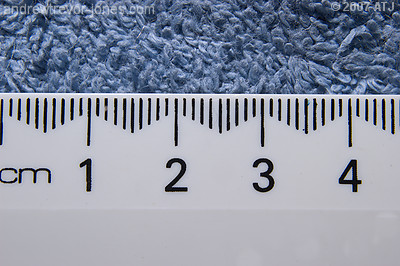
Closest focus for 18-55mm +4 diopter lens at 55mm
Underwater, when using in an Ikelite dome port #5503.50 and the +4 diopter lens, I get around the same magnification when using the bare lens above water.
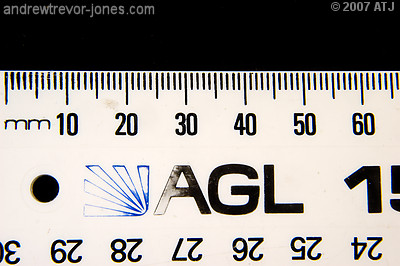
Closest focus for 18-55mm +4 diopter lens at 55mm underwater.
I found that using a +5 diopter lens gives me a little more magnification, or around 1:2.5. This is nowhere near what I can get from the Micro-Nikkor 60mm lens, but the trade-off is the flexibility of subjects. A 50mm (2") long nudibranch is going to come close to filling the frame.
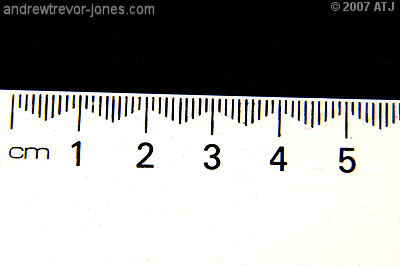
Closest focus for 18-55mm +5 diopter lens at 55mm underwater.
I use mine with an Ikelite dome port #5503.50 and the +5 diopter lens. As already mentioned, this is quite a versatile lens for use underwater. The zoom range means that it can be used for large subjects as well as smaller subjects, although perhaps not tiny subjects such as small nudibranchs. I have used mine for large subjects, such as Port Jackson sharks (Heterodontus portusjacksoni) and turtles down to smaller subjects such as nudibranchs and other "macro" subjects.
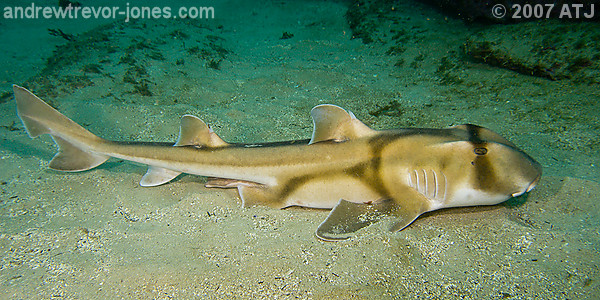
Port Jackson shark, Heterodontus portusjacksoni, shot with Nikon D70 and Nikkor 18-55mm lens at 18mm (cropped top and bottom only).
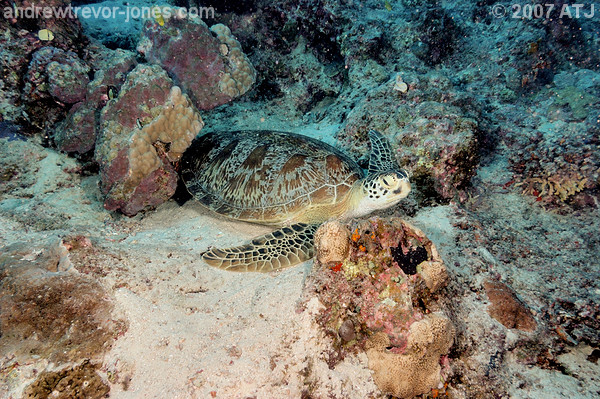
Green turtle, Chelonia mydas, shot with Nikon D70 and Nikkor 18-55mm lens with +5 diopter at 18mm (uncropped).
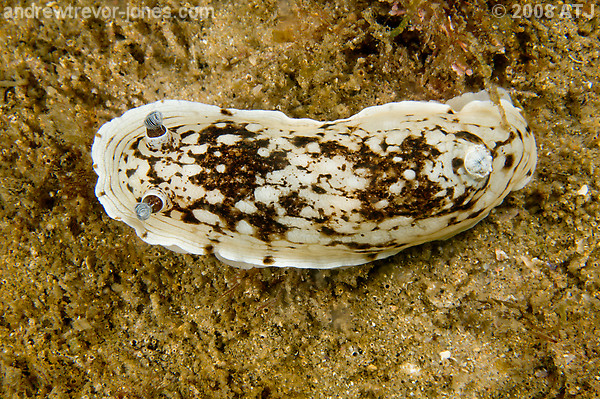
Nudibranch, Aphelodoris varia, shot with Nikon D300 and Nikkor 18-55mm lens with +5 diopter at 55mm (uncropped).

Feather duster worm shot with Nikon D300 and Nikkor 18-55mm lens with +5 diopter at 55mm (uncropped).
The lens works well with fish, too.
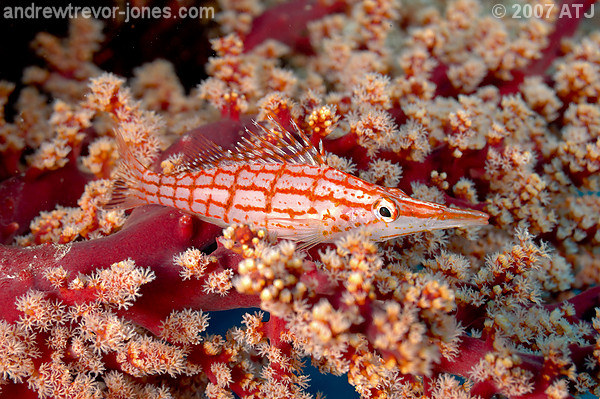
Longnose hawkfish, Oxycirrhites typus, shot with Nikon D70 and Nikkor 18-55mm lens with +5 diopter at 55mm (uncropped).
On my recent trip on Undersea Explorer, I was able to get some good macro shots, like this one:
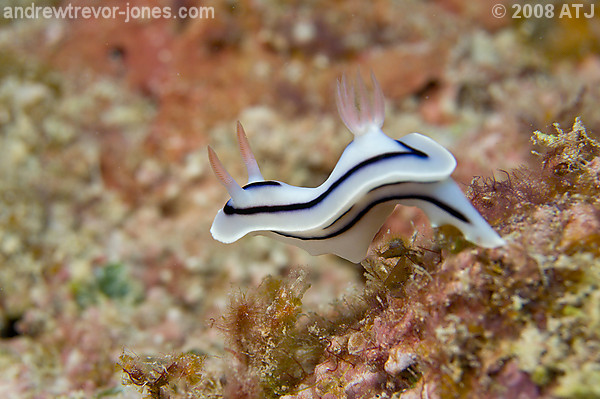
Nudibranch, Chromodoris lochi shot with D300 and Nikkor 18-55mm lens with +5 diopter at 55mm (slightly cropped).
Here are some general reviews of the lens.
Review by Ken Rockwell
Review of the previous version of the lens by Thom Hogan
Review in ePhotozine
Review in Photozone
The only other lens in this range I have used is the D70 kit lens: 18-70mm f/3.5-4.5G.
This is the lens that came with my D70 and was initially my most frequently used lens underwater. I have not used it since I got the 18-55mm lens. While it is generally a good lens with a good zoom range, I found that its closest focusing distance and subsequent reproduction ratio was too limiting. At 70mm, when using a +4 diopter lens, I could only get a reproduction ratio of 1:3.2 which was just not enough for small subjects often encountered on dives. And while the 70mm gives a bit more reach than 55mm, I found that at the closer distances used underwater, there was little difference between the two.
The Nikkor 16-85mm f/3.5-5.6G ED VR was only released this year and looks like a promising lens for underwater work. It has a much wider range that the 18-55mm but the closest working distance is 0.38mm so won't have the same macro capabilities. The Photozone review is rather complimentary. According to the Ikelite port chart, it takes a #5503.85 dome port.
The Nikkor 17-55mm f/2.8 IF-ED would be a great lens for underwater use. Unfortunately, the diameter is too large to operate in the Ikelite port systems.
I have read good reports about the Sigma 17-70mm f2.8-4.5 DC Macro HSM as a versatile underwater lens. The range is comparable to my current lens and it has a better native maximum magnification of 1:2.3. On an Ikelite system, it needs to be used with the 8" dome port. The lens can be had for a reasonable price and it gets a pretty good rap from Photozone.
I purchased this lens in 1996 and use it extensively for macro work above water. It is an absolutely fantastic lens giving sharp results. To date I have only used it on 15 dives, 12 dives in a dome port and 3 in a flat port. It can be a bit limiting, especially in poor visibility, however, it is wonderful for macro work and I really enjoyed it on the last dive I took it (Dive at Bare Island, La Perouse, NSW on 17/05/2008).
Here are the specifications for the lens from Nikon Australia.
| Lens Construction (Groups/Elements) | 7/8 |
| Picture Angle with 35mm (135) format | 39°40' |
| Picture Angle with Nikon DX format | 26°30' |
| Minimum f/stop | 32 |
| Closest Marked Focus Dist [Macro Setting] | 0.219m |
| Maximum Reproduction Ratio [Macro Setting] | 1:1 |
| Filter Attachment Size | 62mm |
| Diameter x Length (extension from lens mount) | 70 x 74.5mmm |
| Weight (approx.) | 440g |
This lens is a true macro lens and at its closest focusing distance it gives a reproduction ratio of 1:1. This means that on a DX camera, a subject that is 24x16mm will fill the frame. The photograph below shows this.
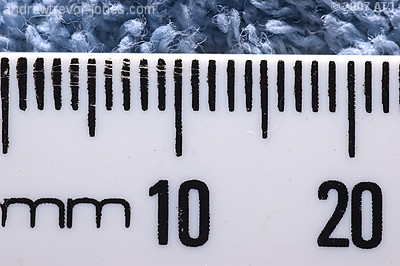
Closest focus for 60mm
The lens can be used in either a dome port or a flat port. Dome ports do not modify the angle of coverage of the lens and so the lens still works as a 60mm lens underwater. However, the dome port creates an apparent image closer than the actual subject and so the lens has to focus closer than it should. This works against the reproduction ratio and so without a diopter lens, the reproduction ratio of this less at its closest focusing distance is somewhat less than 1:1. I have yet to measure this.
A flat port reduces the angle of coverage and also enlarges the image and so the reproduction ratio at the closest focusing distance should be 1:1 or better. I have not yet measured this either.
I have used the 60mm lens with both the Ikelite dome port (#5503.50) and the Ikelite flat port (#5502.41). As mentioned above, I don't get as much magnification with the dome port compared to the flat port but as the angle of view is slightly wider, the lens can be used for more than just macro work. With the lens in the flat port, I am pretty much restricted to only taking macro shots, unless the water is particularly clear. With that limitation understood, it allows taking some really beautiful macro shots mainly because I can get so close to the subject, reducing the amount of water through which the light must pass.
As already mentioned, the big limitation with the lens in either the dome port and more so in the flat port is that if you encounter anything large, you either have to pass on taking photographs, or live with getting a shot of only part of the animal.
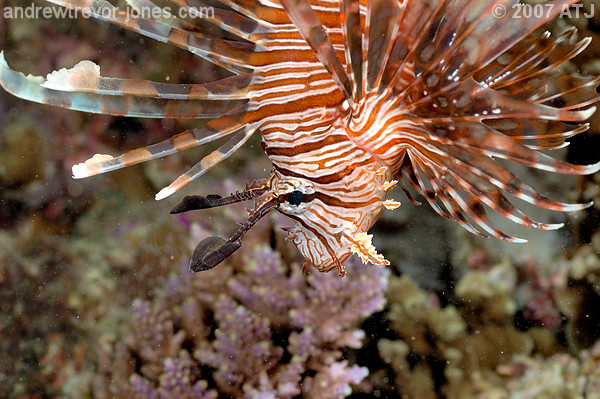
Lionfish, Pterois volitans, shot with Nikon D70 and Micro-Nikkor 60mm (no diopter) in dome port (uncropped).
Of course, getting part of an animal can make for an interesting photograph.
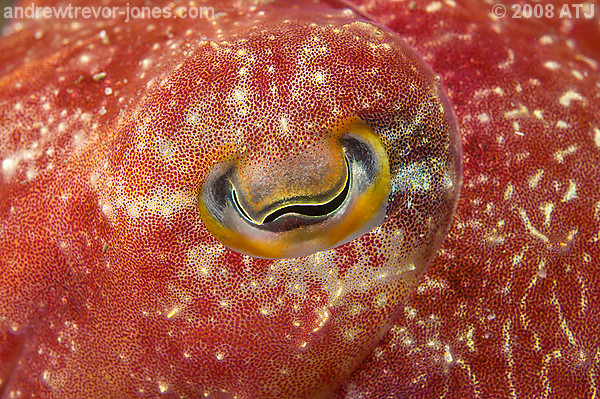
Eye of reaper cuttlefish, Sepia mestus, shot with Nikon D300 and Micro-Nikkor 60mm in flat port (uncropped).
I have shot a wide range of subjects with the 60mm lens behind the dome port. As mentioned above, the dome port gives a little more angle of coverage and so slightly larger subjects can be accommodated than the flat port. The trade off is lack of magnification of very small subjects. Since July 2008, I have used a +4 diopter on the 60mm lens when using it behind a dome port. This gets the possible magnification back to 1:1. The dome port is quite close to the subject when at 1:1 but there is still just enough space for lighting.
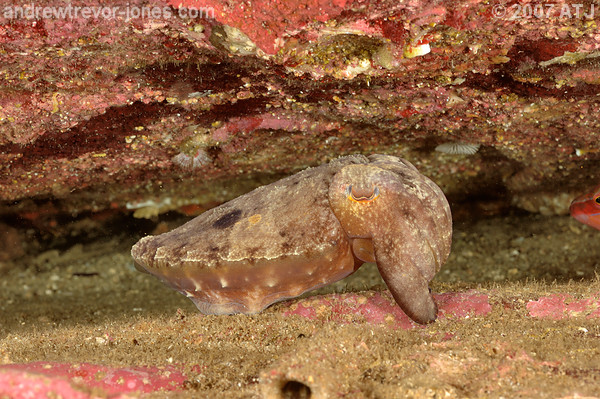
Reaper cuttlefish, Sepia mestus, shot with Nikon D70 and Micro-Nikkor 60mm (no diopter) in dome port (uncropped).
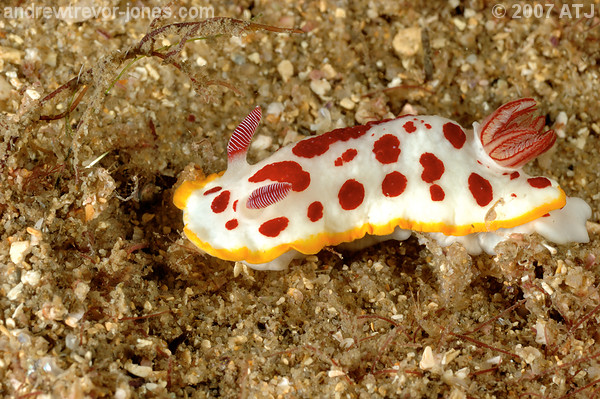
Nudibranch, Chromodoris splendida, shot with Nikon D70 and Micro-Nikkor 60mm (no diopter) in dome port (uncropped).

Nudibranch, Noumea sulphurea, shot with Nikon D300 and Micro-Nikkor 60mm with +4 diopter in dome port (uncropped).
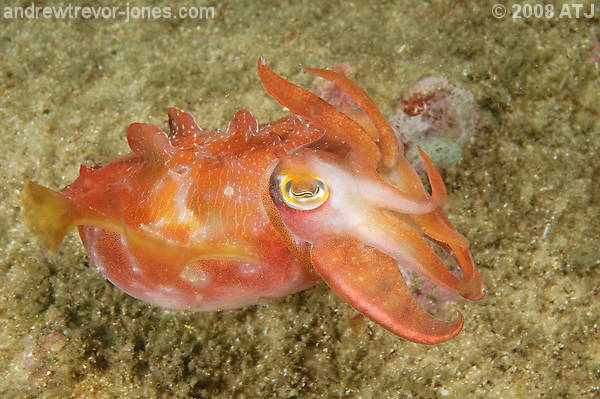
Reaper cuttlefish, Sepia mestus, shot with Nikon D300 and Micro-Nikkor 60mm with +4 diopter in dome port (uncropped).
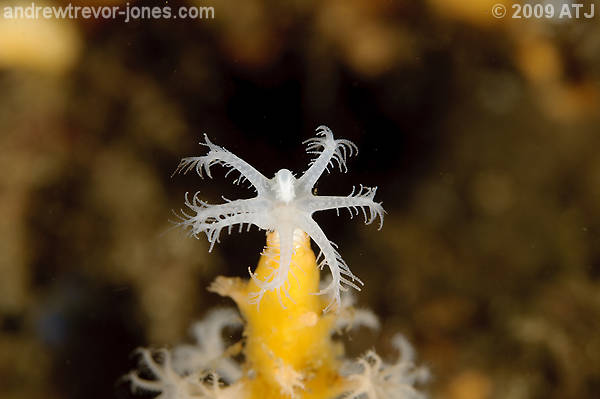
Soft coral, Carijoa sp., shot with Nikon D300 and Micro-Nikkor 60mm with +4 diopter in dome port (uncropped).
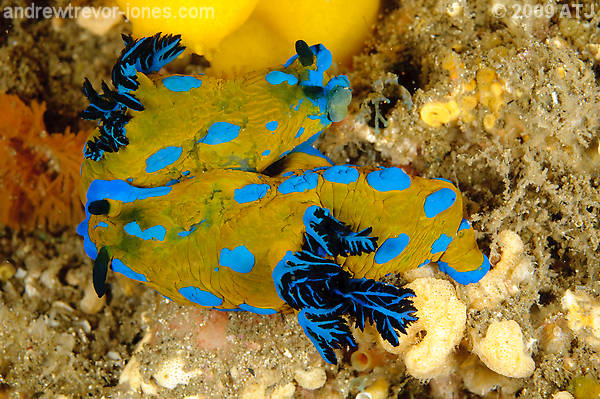
Nudibranch, Tambja verconis, shot with Nikon D300 and Micro-Nikkor 60mm with +4 diopter in dome port (uncropped).
The flat port is perfect for macro work and allows subjects as small as one centimetre in length to be captured. I have only used the flat port for three dives but am very happy with the results so far.
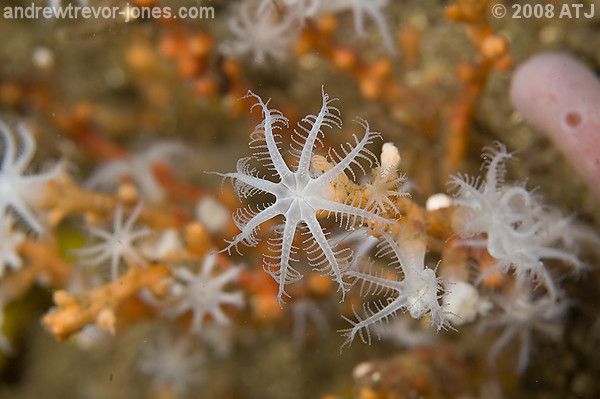
Soft coral, Carijoa sp., shot with Nikon D300 and Micro-Nikkor 60mm in flat port (uncropped).
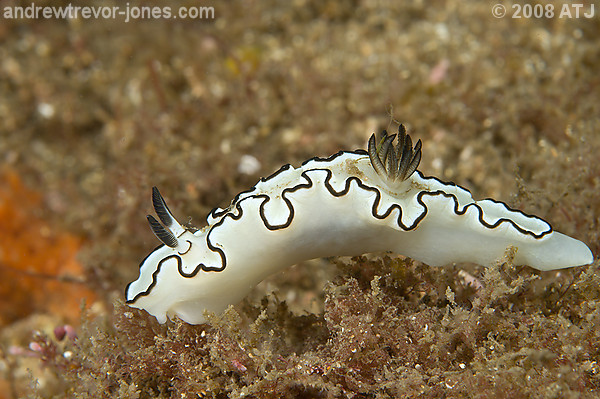
Nudibranch, Glossodoris atromarginata, shot with Nikon D300 and Micro-Nikkor 60mm in flat port (uncropped).
Here are some reviews of the 60mm lens.
Review by Ron Reznick
Review by Michael Weber
Review by Photozone
This discontinued lens is basically the 105mm equivalent of my 60mm lens. It also focuses to 1:1 and so could be used for most of the same subjects. It will have a greater working distance for the same magnification. This will be an advantage for small skittish animals, as well as being able to light smaller subject better because of the large gap between the port and the subject. The disadvantage would be more water between the port and the subject, more noticeable with larger subjects that already require a greater distance. While using my 60mm I have yet to feel the need for more reach (that the 105mm would provide) and have benefitted from being able to get some shots of larger subjects which would be compromised by the 105mm.
This is a newer VR version of the above lens and will be very similar to the lens above for underwater use. I doubt that VR would be required or even useful underwater, especially using strobes.
I only recently found out about this lens even though it was released in 1997. It has now been discontinued and they are difficult to obtain. All reports I have seen suggest this is a very good lens for above water and I have seen a few people swear by it for underwater use, especially on dives with a lot of macro subjects. I would love to have this lens for above water shots but it appears it can't be used with Ikelite housings.
I bought this lens recently mainly for taking photographs of sharks and whales. I have only used it for three dives so far and they were not great. On the first dive with the lens the visibility was very poor with a lot of particulate matter in the water. I also saw few large subjects. The second and third dives were to a location off one of Sydney's beaches that is frequented by grey nurse sharks, Carcharias taurus. The conditions were perfect with clear water and there were 6-7 sharks hanging around a cave. It was on those two dives that the dual sync cord to drive my strobes failed. I did manage to get a couple of satisfactory shots but did not get to put the lens through its paces.
Here are the specifications for the lens from Tokina.
| Lens Construction (Groups/Elements) | 11/13 |
| Minimum f/stop | 22 |
| Closest Focus Distance | 0.30m (11.8") |
| Maximum Reproduction Ratio | 1:8 |
| Filter Attachment Size | 77mm |
| Diameter x Length (extension from lens mount) | 84 x 89.5mmm |
| Weight (approx.) | 570g |
Above water, the lens focuses to 30 centimetres, however, because of the wide angle of coverage the magnification is still only 1:8 at this distance. This means that a subject around 19x12.5cm will fill the frame. I have yet to determine what the magnification will be underwater. I initially used this lens with a +2 diopter but now use a +4 diopter as it gives me more magnification and better edge sharpness.
I have not used this lens enough (with things going well), but my early experiences are promising. The couple of shots I did get were pretty good considering I was preoccupied with the failing strobes. I did manage to get one shot with the strobes working.

Grey nurse shark, Carcharias taurus, shot with Nikon D300 and Tokina 12-24mm with +2 diopter at 12mm using available light (uncropped).

Grey nurse shark, Carcharias taurus, shot with Nikon D300 and Tokina 12-24mm with +2 diopter at 12mm using strobes (uncropped).
I used this lens a few times on my recent trip on Undersea Explorer and I'm happy with the way it worked for both large and small subjects.
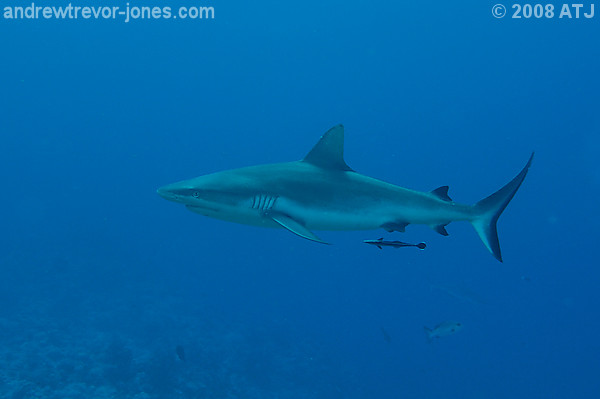
Grey reef whaler, Carcharhinus amblyrhynchos, shot with Nikon D300 and Tokina 12-24mm with +2 diopter at 24mm (cropped to around 75%).

Basket star, Astroboa nuda, shot with Nikon D300 and Tokina 12-24mm with +2 diopter at 12mm (cropped to around 75%).
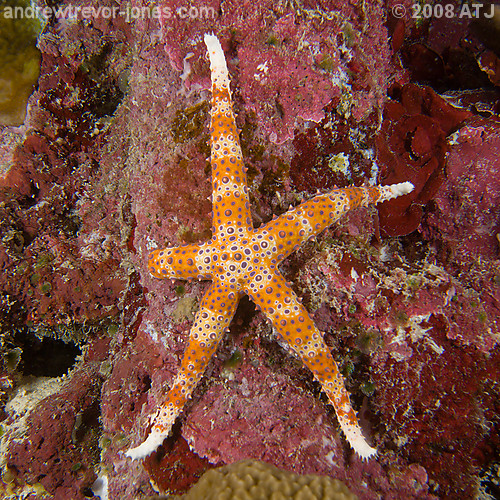
Egyptian sea star, Gomophia egyptiaca, shot with Nikon D300 and Tokina 12-24mm with +2 diopter at 24mm (cropped from 4288x2848 to 2345x2345 ).

Port Jackson shark, Heterodontus portusjacksoni, shot with Nikon D300 and Tokina 12-24mm with +4 diopter at 12mm (uncropped).
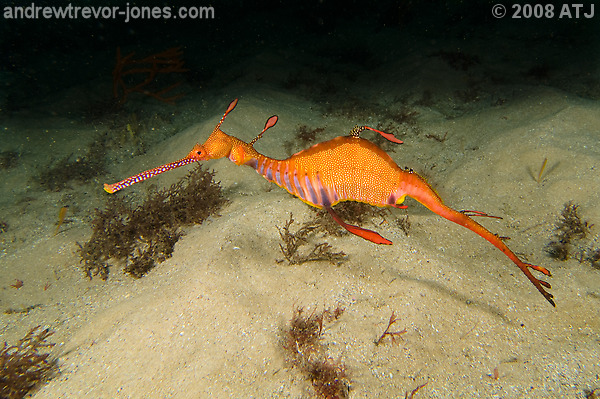
Weedy seadragon, Phyllopteryx taeniolatus, shot with Nikon D300 and Tokina 12-24mm with +4 diopter at 12mm (cropped from 4288x2848 to 3350x2225 ).
Here is a review of the Tokina 12-24mm lens.
By all reports, this lens is similar to the Tokina 12-24mm although optically better. It also costs twice as much which is why I went for the Tokina. If I had the money, I would have gone for the Nikon.
The Nikkor 14-24mm f/2.8G would be an excellent lens for underwater work, especially on a full frame camera like the D3. Unfortunately, its diameter is too large to fit the Ikelite port systems.
The Tokina 10-17mm f/3.5-4.5 Fisheye is a very popular lens for underwater use. Some say it is better than the 12-24 because it forces you to get closer to subject (which is always a good thing underwater). I must admit that I did not consider this lens when I went for a lens for large subjects. In hindsight, I probably wouldn't have got it anyway as my strobes can only just provide coverage for the 12-24mm at 12mm, and that is with the diffusers in place. I haven't used the 12-24mm long enough to know if I need that extra bit of coverage. I guess I'll know soon enough.